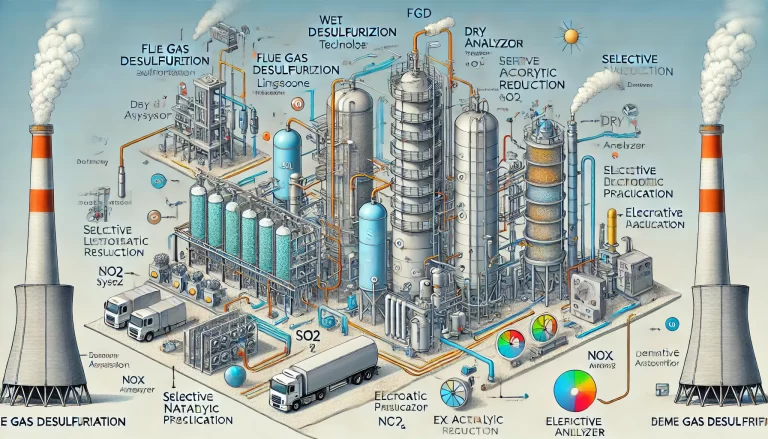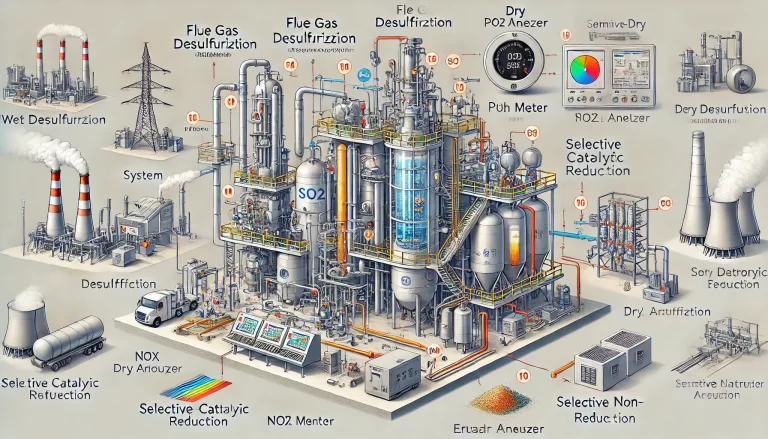1. Introduction
The reduction of sulfur dioxide (SO₂) and nitrogen oxides (NOₓ) in industrial flue gas is essential for mitigating environmental pollution and complying with air quality standards. The primary technologies employed for these purposes are Flue Gas Desulfurization (FGD) and Denitrification. In this article, we will explore the main desulfurization and denitrification techniques, their respective processes, and the critical instruments that facilitate their operation.
2. Desulfurization (FGD)
Desulfurization refers to the removal of sulfur dioxide (SO₂) from flue gas, which is a common byproduct of burning fossil fuels. Various methods are employed to achieve effective desulfurization, including wet, dry, and semi-dry techniques.
2.1 Wet Desulfurization
Wet desulfurization, especially the lime-gypsum method, is one of the most widely used technologies in large-scale power plants.
Process Overview:
- Absorbent: Limestone (CaCO₃) is used as the absorbent.
- Chemical Reaction: SO₂ reacts with CaCO₃ to form calcium sulfite (CaSO₃), which is then oxidized to form gypsum (CaSO₄·2H₂O).
- Efficiency: Typically achieves removal rates of 90%-98%.
Key Equipment:
- SO₂ Gas Analyzer: Measures the SO₂ concentration before and after treatment to monitor efficiency.
- pH Meter: Monitors the pH of the absorbent slurry (maintained between 5.5 and 6.5).
- Flow Meters: Measure the flow of limestone slurry to ensure optimal absorption.
- Radar and Ultrasonic Level Sensors: Monitor the level of slurry in the absorption tower to prevent overflow or dry operation.
2.2 Dry Desulfurization
Dry desulfurization methods involve using a solid absorbent, such as activated carbon or sodium bicarbonate (NaHCO₃), to capture SO₂ from flue gas.
Process Overview:
- Absorbent: Activated carbon or sodium bicarbonate.
- Chemical Reaction: SO₂ is neutralized by the absorbent, forming solid byproducts like calcium sulfate (CaSO₃).
- Efficiency: Generally lower than wet methods (around 70%-90%) but produces no wastewater.
Key Equipment:
- SO₂ Gas Analyzer: Measures SO₂ concentration.
- Spray System Flow Meters: Control the flow of absorbent slurry.
- Dust Monitoring Equipment: Measures the particulate content in the flue gas to ensure that the removal of solid byproducts is effective.
2.3 Semi-Dry Desulfurization
In semi-dry desulfurization, spray-drying technology is applied, which uses calcium hydroxide (Ca(OH)₂) or sodium bicarbonate to neutralize SO₂ and form solid byproducts.
Process Overview:
- Absorbent: Calcium hydroxide or sodium bicarbonate.
- Chemical Reaction: Similar to dry desulfurization, but with the addition of a spray-drying system to maximize surface contact.
- Efficiency: Typically around 80%, but it involves less waste compared to wet methods.
Key Equipment:
- SO₂ Gas Analyzer
- Spray System Flow Meters
- Electrostatic Precipitators (ESP): Capture the particulate matter in the exhaust.

3. Denitrification (DeNOₓ)
Denitrification refers to the removal of nitrogen oxides (NOₓ) from flue gas. The two most common methods are Selective Catalytic Reduction (SCR) and Selective Non-Catalytic Reduction (SNCR).
3.1 Selective Catalytic Reduction (SCR)
SCR is a high-efficiency process that uses ammonia (NH₃) as a reducing agent and a catalyst to convert NOₓ into nitrogen (N₂) and water (H₂O).
Process Overview:
- Reagents: Ammonia or urea.
- Reaction: NOₓ reacts with ammonia in the presence of a catalyst (e.g., vanadium oxide) to form N₂ and H₂O:
- 4NO + 4NH₃ + O₂ → 4N₂ + 6H₂O
- Temperature Range: 300-400°C.
- Efficiency: Achieves removal rates of 80%-90%.
Key Equipment:
- NOₓ Analyzer: Monitors NOₓ concentration at various stages.
- Ammonia Escape Monitoring System: Ensures the correct amount of ammonia is used to prevent excess emissions.
- Flow Meters: Control the injection rate of ammonia.
- Temperature Sensors: Monitor the reaction temperature to optimize catalyst performance.
3.2 Selective Non-Catalytic Reduction (SNCR)
SNCR is a more cost-effective method suitable for smaller boilers, where ammonia or urea is injected into high-temperature regions to reduce NOₓ without the need for a catalyst.
Process Overview:
- Reagents: Ammonia or urea.
- Reaction: The high-temperature flue gas (850-1100°C) reacts with ammonia or urea, converting NOₓ to N₂ and H₂O.
- Efficiency: Typically 30%-50%, which is lower than SCR.
Key Equipment:
- NOₓ Analyzer: To monitor the reduction process.
- Injection System Flow Meters: Control the amount of ammonia or urea injected into the high-temperature region.
- Temperature Sensors: Ensure that the reaction occurs within the optimal temperature range.
4. Integrated Desulfurization and Denitrification Process
To optimize efficiency and minimize capital costs, some power plants adopt integrated desulfurization and denitrification technologies, such as electron beam treatment or activated carbon adsorption. These methods combine desulfurization and denitrification into a single process, allowing for the simultaneous removal of both SO₂ and NOₓ from flue gas.

5. Conclusion and Summary
The desulfurization and denitrification processes are critical for reducing air pollution from industrial emissions. The typical treatment sequence follows Denitrification (DeNOₓ) → Dust Removal → Desulfurization (DeSOₓ), ensuring efficient removal of pollutants.
Key Control Parameters:
- NOₓ and SO₂ concentrations.
- Ammonia escape levels.
- Slurry pH levels.
- Gas flow, temperature, and pressure.
Main Equipment:
- Denitrification Reactors (SCR/SNCR)
- Absorption Towers
- Electrostatic Precipitators
- Flue Gas Analyzers
- Spray Systems
Proper instrumentation is essential for achieving optimal performance in desulfurization and denitrification systems, ensuring high pollutant removal efficiency while minimizing operational costs.
